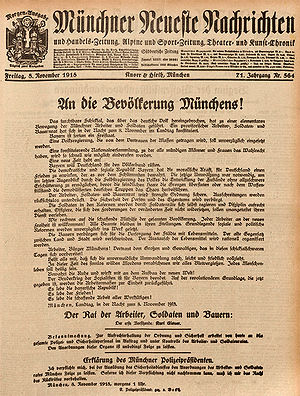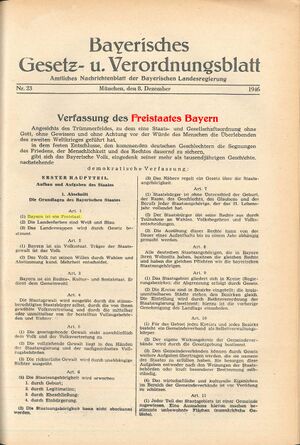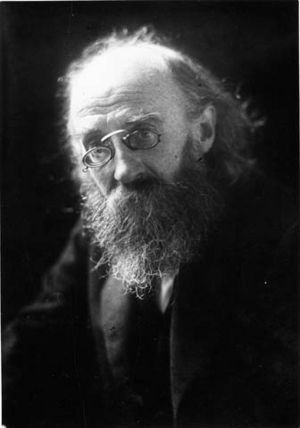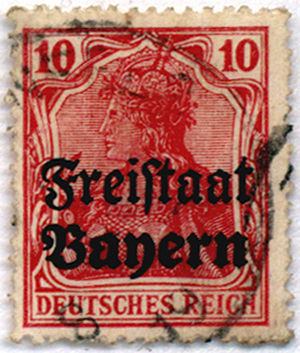EN:Free State of Bavaria (Freistaat Bayern)
From Historisches Lexikon Bayerns


Since 1919, the Bavarian state name has officially been "Freistaat Bayern" (Free State of Bavaria). Originally, "Free State" meant freedom from the German Reich, then, as the German equivalent of "Republic", the opposite of the monarchy. In 1918/19 the word prevailed as the general designation of the former German federal states and now parts of the Weimar Republic. Since the 1960s it has stood above all for the federalist policy and cultural identity of the federal state of Bavaria within the Federal Republic of Germany.
History of the Word "Freistaat" until 1918
The word "Freistaat" (Free State) was first used in 1731 to designate the independence of the Swiss Confederation from the Holy Roman Empire of the German Nation since 1648. In the context of Enlightenment and the emergence of the republics in North America and France, as well as in the course of the linguistic phenomenon of the Germanisation of expressions, "Freistaat" as a free translation of "republic" referred to a form of government that guaranteed the political and personal freedom of all citizens. In the course of the liberal and democratic movements in the first half of the 19th century, this meaning narrowed down to the opposite of the monarchical form of government; King Louis I used the term in this sense in his abdication deed of 1848. After the failure of the revolution of 1848, the terms "republic/free state" largely disappeared from political vocabulary. At the beginning of the 20th century it was replaced by the word "Volksstaat" (people's state), which could also be used to describe a parliamentary monarchy.
"Freistaat" in the Weimar Republic
Kurt Eisner's (USPD [Unabhängige Sozialdemokratische Partei Deutschlands - Independent Social Democratic Party of Germany], 1867-1919) proclamation of 8 November 1918 contained the sentence: "Bayern ist fortan ein Freistaat." ("Bavaria is a Free State from now on."), but it also referred to the "Republic". In the media and official bodies, the modern term "Volksstaat" was predominantly used at first. From about November 1918 to February 1919, there was a de facto language regulation in the German Reich, which was especially applied by Hugo Preuß (1860-1925), Secretary of State and later Reich Minister of the Interior. Accordingly, "Republic" was to be primarily applied to the German Reich, whereas its constituent parts, the former German confederate states, were referred to as “Free States”. This regulation was laid down in the Law on the Provisional Imperial Authority of 10 February 1919. With direct reference to this, Bavaria included the word "Freistaat" in its Basic State Law passed in the Cabinet on 20 February 1919. However, it was only officially designated as a state name on the initiative of Minister-President Johannes Hoffmann (SPD [Sozialdemokratische Partei Deutschlands - Social Democratic Party of Germany], 1867-1930), who understood it at the same time as a combat term against the "dictatorship" of the "Räterepublik" (soviet republic) and published an official newspaper with the name "Der Freistaat" (The Free State). Although almost all German states included the word "Freistaat" in their constitutions, it no longer played a role in public awareness after 1919.
"Freistaat" after 1945
At the constitutional deliberations of 1946, with the crucial participation of Minister-President Wilhelm Hoegner (SPD, 1887-1980), the old state name was taken up again with reference to its anti-monarchical significance and preferred as a German expression to "republic". The connotation of white-blue, "stubborn" Bavaria, which was the only western state in the Federal Republic of Germany to carry this name, has emerged as a new meaning of the term "Free State" since the late 1950s. The federalist definition of the term was one of the decisive factors for the conscious adoption of the state name "Free State of Saxony" in 1990 and "Free State of Thuringia" in 1993.
References
Further research
External links
Related articles
Freistaat Bayern, Free State of Bavaria
Cite
Johannes Merz, Free State of Bavaria (Freistaat Bayern), published 03 July 2006, english version published 17 February 2020; in: Historisches Lexikon Bayerns, URL: <http://www.historisches-lexikon-bayerns.de/Lexikon/EN:Free_State_of_Bavaria_(Freistaat_Bayern)> (20.04.2024)


